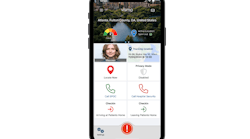Today, over 240 million calls are made to 911 in the U.S. each year. A major city, such as Chicago, is itself responsible for approximately 8.4 million of these calls. For more than four decades, the public has been relying on 911 centers – also known as Public Safety Answering Points (PSAP) – to get help during emergencies and disasters. Interestingly enough, the same core 911 platforms and supporting technologies that were in place 40 years ago, are still in place today.
Handling a simple 911 call involves many complicated steps, simplified here: A person with an emergency initiates an emergency call to a 911 center. The information about the call for service is inputted into the Computer-Aided Dispatch (CAD) system. A dispatcher then receives the call information from the call-taker and dispatches the call using two-way radios to those responsible and available units based on the incident. Responders receive the incident information utilizing mobile data terminals (MDTs) or mobile data computers (MDCs). The communication and data are stored for further investigation, reporting or training purposes.
Traditional CAD systems from 40 years ago supported this workflow admirably. But over the past decade, these systems have been stretched to their limits by the need to accommodate new and emerging technologies including:
- Geo-locating a caller’s position based on the introduction of mobile devices;
- Acceleration of VoIP adoption;
- Tracking public safety resources – such as Police/ Fire – via AVL/GPS;
- Video integration to support safe cities programs;
- Predictive analyses using big data to prevent future crimes;
- Social media monitoring to increase situational awareness;
- Incorporating texting, to share pictures and videos with 911 operators;
- Drone technologies in police/fire/ems as lead responding units;
- Big data tools to manage the massive data that produced by these technologies; and
- Sophisticated tools to create predictive analytics to manage and foresee future crimes.
To highlight one – if not the most important – technological impacts on the 911 system architecture: Proliferation of cellular phones have laid the foundation of sharing additional valuable and important information with the 911 call centers such as text, picture, video messaging and more accurate, reliable location information. In the U.S. today, over 70 percent of 911 calls are placed from wireless phones, and the rate is increasing every day. We often see that people are retiring their landline in their homes and businesses and relying on wireless as their primary phone device.
One major issue with using cell phones to initiate a 911 call is that current 911 systems will misrepresent the caller’s location. With traditional 911 technologies, locating a 911 caller is extremely hard and not accurate. It is important to consider that some areas in the country can offset a caller’s location .5 miles – and as far as 2 to 3 miles – from their original location on the 911 operator’s system map. One might ask, "if some smartphone applications on my phone, like Uber or MapMyRun, can pinpoint my location accurately, how come 911 systems cannot do the same?" The answer is simple: because all our 911 cell calls are routed through the nearest cellphone towers or closest neighboring 911 system based on caller’s location. When using your cell phone to call 911, it is important to tell the operator where you are, even when using a land line.
In 2000, The National Emergency Number Association (NENA) recognized the changes in technology and created a standard to accommodate these technology enhancements called "Next Generation 911" or "NG911." Very high level, NG911 is an IP-based network (ESInet) system that delivers voice, video, text and data "calls" to the PSAP, and eventually to the first responders. As a result, a wealth of information can flow flawlessly through the 911 system from the public to first responders and beyond. Additionally, NG911 and associated infrastructure initiatives will address the previously mentioned location issues to provide accurate, location-based 911 services. Utilizing NG911 will help us to shift away from antiquated 40-year old technology to a faster more reliable, flexible, resilient and scalable 911 system to keep up with the changes.
The technology has long been available to transition from out-of-date 911 systems to IP-based NG911. The major holdup for the implementation has been cost, limitations on personnel, lack of training and issues with interoperability. It seems like all these issues are being addressed and the public sector is getting ready for the move to NG911.
In order to accelerate the implementation of NG911 services throughout the U.S, national public safety thought leaders, along with leaders from 911 communities and government partners, created the NG911 NOW coalition in an effort to implement NG911 services by 2020. The Coalition consists of members from the National Association of State 911 Administrators (NASNA - www.nasna911.org), the Industry Council for Emergency Response Technologies (iCERT - www.theindustrycouncil.org), the National Emergency Number Association (NENA - www.theindustrycouncil.org) and representatives from NG911 Institute - www.ng911institute.org. Their mission is multi-fold: to promote more effective emergency calling and response services in public safety; retire all legacy primary and secondary PSAPs; create a structure for all 911 centers to be efficiently funded; finalize policies, and fine-tune NG911 best practices by 2020. According to NG911Now coalition, the end goal to expedite the process has the following benefits:
- Increase compatibility with emerging communication trends
- Enhance the flexibility, reliability, and survivability of the nation’s 911 system
- Improve emergency response for the public and emergency responders
- Reduce the cost of operating the 911 system
The National Telecommunications Information Administration (NTIA) was directed to establish a First Responder Network Authority (FirstNet) in 2012. FirstNet, which consists of 15 independent agencies, is responsible for the oversight of the design, deployment and ongoing operations of a nationwide wireless broadband network. In early 2016, the national FirstNet program began lobbying for a comprehensive, nationwide broadband network to support the nation’s first responder’s community. Once it is completed, FirstNet will enable dispatchers from PSAP operators to process and share critical data using NG911, and share this data with first responders. This collaboration will enable better communication with first responders during emergencies, and allow agencies to improve response times and save lives. When it comes to emergency and first responder communications, NG911 and FirstNet form a natural partnership. Both NG911 and FirstNet share the same goal of improving communications during emergencies through a nationwide, IP-based technology architecture.
To be clear, the NG911 is much more than just a new set of computers and adding a couple of innovative functionalities. NG911 focuses on sharing information with others entities, updating policies, enhancing training, utilizing best practices, adapting changes to faster and more informed responses with intelligent and actionable data. Many states are already developing plans and are creating plans to adapt NG 911 in near future, as early as 2020.
As of December 2015, the United States had more than 6,000 primary PSAPs (where the phone rings when you call 911) and secondary PSAPs (where a 911 call may be transferred to or from). In the next five years, we will see more and more PSAPs are being upgraded to NG911 under the umbrella of the NG911 NOW coalition.
The NG911 mandate is coupled with the undeniable fact that it is getting harder and harder to maintain, support and enhance the old 911 systems to accommodate these new technologies. In order to accommodate and implement new changes, existing 911 systems are requiring heavy customization and big financial backing from municipalities. CAD software providers are now obligated to catch up with the changing technologies in order to stay in the game. Why? Aside from achieving their organization’s business objectives, CAD product manufacturers understand that the general public’s expectations of 911 haven’t changed since inception: the systems must work, no matter what.
Under the NG911 NOW coalition initiatives, we will see more and more PSAPs are being upgraded to NG911 by 2020. This is a very aggressive timeline, but achievable. Advanced system integrators with public safety operations expertise and working knowledge of complicated 911 center expertise can provide municipalities with a roadmap to an adaptation of NG911.
Editor's Note: This article is from the November/December 2016 issue of Security Technology Executive magazine.
About the Author: Yilmaz Halac is Director of Client Deliver for SDI Solutions in Chicago. Mr. Halac previously served as managing deputy director for the City of Chicago Office of Emergency Management and Communications (OEMC), overseeing technology for Chicago Police (CPD), Chicago Fire (CFD), 311 (non-emergency) and OEMC - 911. He was a member of the Public Safety Technology Consortium, a group which consists of CFD, CPD, OEMC, Health Department and Aviation. He was responsible for the research, planning and development of new technologies for all the public safety agencies. Mr. Halac is well-credentialed in large-scale, event-based security management, having worked on the planning for the recent NATO Summit in Chicago in 2012, as well as serving as a member of the Critical Infrastructure Protection Subcommittee along with the U.S. Secret Service, FBI, DHS and other high profile supporting agencies. He has presented at numerous national and international technology conferences and has several DHS certifications and recognitions from various government organizations.


